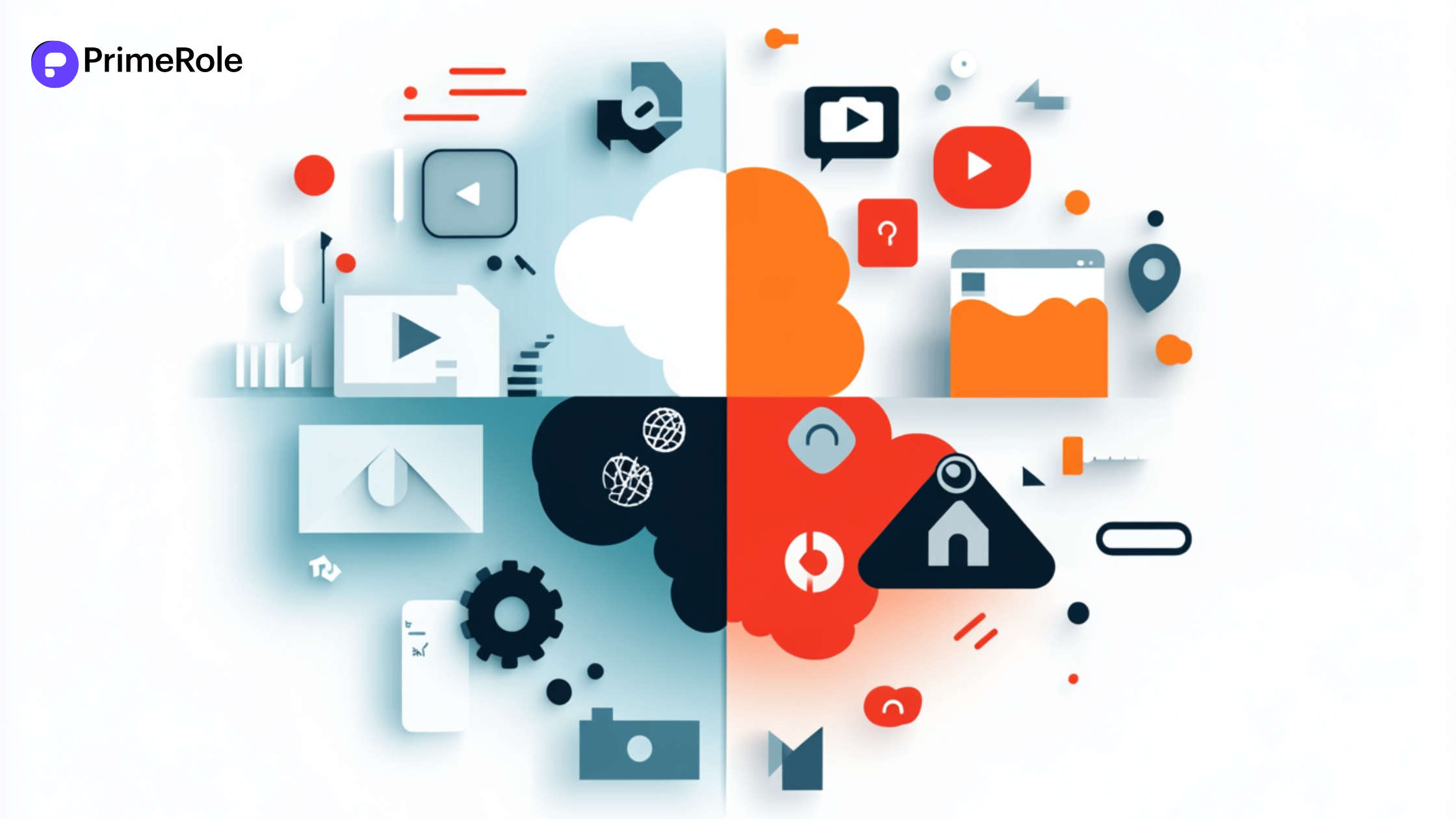
Introduction
Marketing changes over time. However, the two foundational instruments businesses still go to are inbound and outbound marketing. Both strategies aim to attract customers and generate leads, yet they differ in execution, cost, and effectiveness. Understanding the differences between the two and how they fit into your business strategy is essential for long-term success. Should you prioritize inbound, outbound, or a combination of both? This guide provides an in-depth comparison of inbound vs. outbound marketing, covering:
- The fundamental differences between inbound and outbound marketing
- The benefits and challenges of each approach
- How to select the right strategy for your business
- How to successfully combine both strategies for maximum impact
You will find a clear understanding at the end of this guide of which marketing strategy is the most appropriate for your business aims and a step-by-step guide about marketing optimization for sustainability growth.
Table of Contents:
- What is Inbound Marketing?
- What is Outbound Marketing?
- Key Differences: Inbound vs Outbound Marketing
- Pros & Cons of Inbound and Outbound Marketing
- Which Strategy is Right for Your Business?
- How to Combine Inbound & Outbound Marketing for Maximum Impact?
- The Role of Technology in Marketing Strategies
- Case Studies: Successful Inbound and Outbound Campaigns
- Trends in Inbound and Outbound Marketing for 2025 and Beyond
- Conclusion
- Frequently Ask questions(FAQs) on Inbound vs Outbound Marketing
What is Inbound Marketing?
Inbound marketing is a customer-centric approach that focuses on attracting potential buyers through valuable content, search engine optimization (SEO), and engagement rather than direct outreach. The goal is to create meaningful connections with potential customers by providing information that addresses their needs and interests.
1. Key Characteristics of Inbound Marketing
- Permission-Based: Customers seek out and engage with businesses voluntarily.
- Value-driven: Focuses on solving customer pain points rather than directly selling.
- Long-Term Strategy: Builds trust, credibility, and authority over time.
2. Examples of Inbound Marketing Strategies
- Content Marketing: Creating high-quality blogs, articles, eBooks, whitepapers, and guides.
- Search Engine Optimization (SEO): Optimizing content to rank higher in search engine results and attract organic traffic.
- Social Media Marketing: Engaging with audiences on platforms such as LinkedIn, Instagram, Facebook, and Twitter.
- Email Marketing: Sending newsletters and personalized messages to nurture customer relationships.
- Webinars and Podcasts: Providing educational content to inform and engage audiences.
3. Benefits of Inbound Marketing
- Cost-Effective: Generates leads at a lower cost compared to outbound marketing.
- Higher Quality Leads: Attracts prospects genuinely interested in your products or services.
- Improves Brand Awareness: Establishes your brand as an authority in the industry.
- Enhances Customer Loyalty: Builds trust and long-term relationships with customers.
- Better Conversion Rates: Educated and engaged leads are more likely to convert into customers.
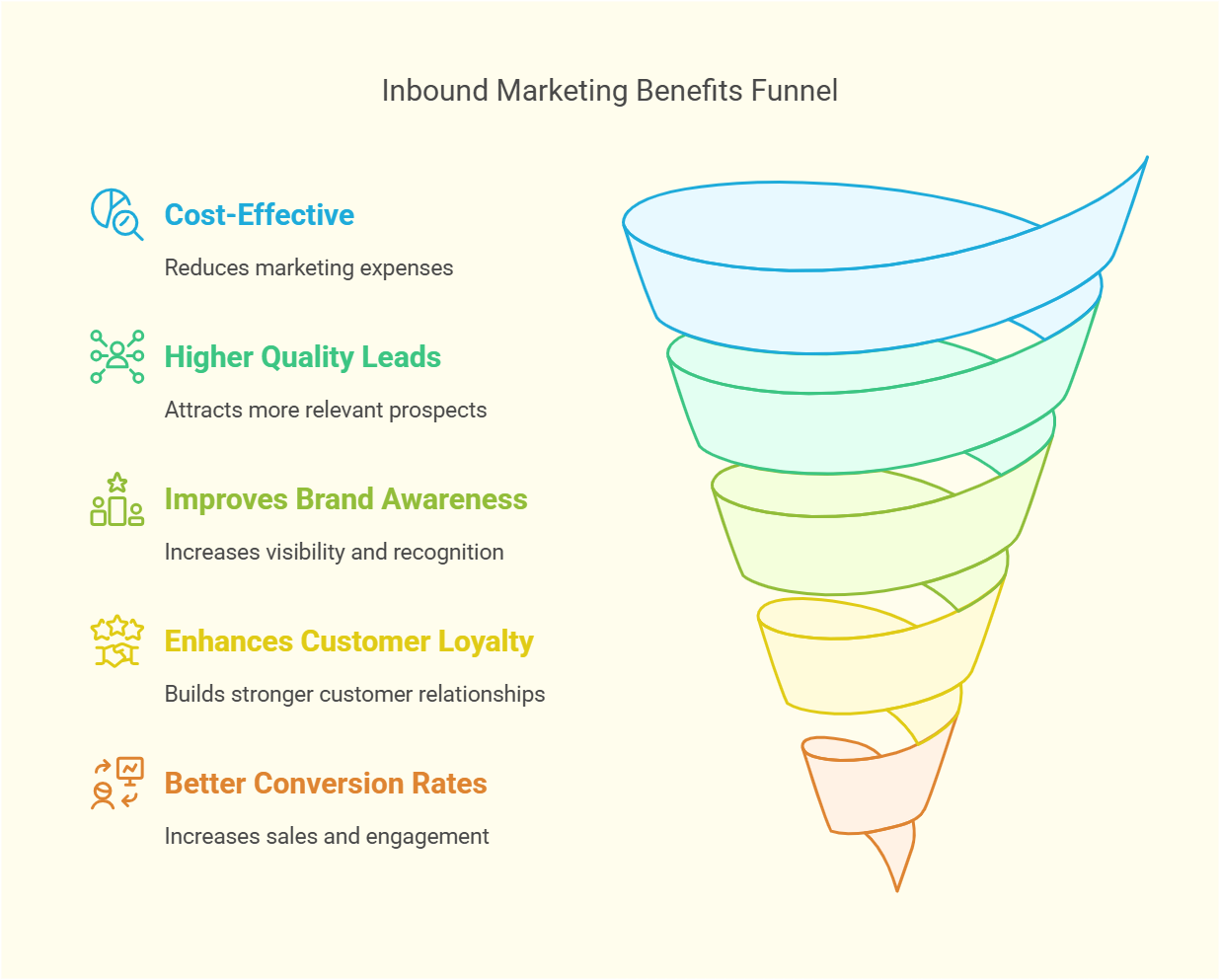
4. Inbound Marketing vs. Outbound Marketing
- Inbound: Attracts customers through valuable content and organic search.
- Outbound: Uses direct advertising, cold calling, and paid promotions to reach audiences.
- Effectiveness: Inbound is more sustainable and cost-efficient in the long run.
5. Stages of the Inbound Marketing Funnel
- Attract: Draw potential customers through blogs, SEO, and social media.
- Convert: Capture leads with landing pages, forms, and calls to action (CTAs).
- Close: Nurture leads through email marketing and personalized offers.
- Delight: Retain customers by providing valuable experiences and support.
6. Tools for Effective Inbound Marketing
- SEO Tools: Google Analytics, SEMrush, Ahrefs.
- Content Marketing Tools: HubSpot, WordPress, Grammarly.
- Email Marketing Tools: Mailchimp, ConvertKit.
- Social Media Tools: Hootsuite, Buffer.
7. Measuring the Success of Inbound Marketing
- Website Traffic: Monitor visits, page views, and time on site.
- Lead Generation: Track form submissions and email sign-ups.
- Engagement Metrics: Measure social media interactions, shares, and comments.
- Conversion Rates: Analyze the percentage of leads turning into customers.
Inbound marketing is a long-term investment that nurtures potential customers, leading to higher-quality leads and sustainable business growth.
What is Outbound Marketing?
Outbound marketing is a business-driven approach where potential customers are actively reached through advertising, direct marketing campaigns, and sales tactics. Unlike inbound marketing, which relies on organic attraction, outbound marketing pushes marketing messages to a wide audience.
1. Key Characteristics of Outbound Marketing:
- Interruption-Based: Marketing messages are often delivered to consumers without prior engagement.
- Direct and Immediate: Focuses on generating quick conversions.
- Paid and Promotional: Often requires financial investment in advertising.
2. Examples of Outbound Marketing Strategies:
- Traditional Advertising: TV commercials, radio ads, print media, and direct mail campaigns.
- Cold Calling and Cold Emails: Reaching out to potential clients without prior engagement.
- Pay-Per-Click (PPC) Advertising: Running targeted online ads on platforms like Google Ads, Facebook Ads, and LinkedIn Ads.
- Billboards and Outdoor Advertising: Large-scale advertising campaigns aimed at reaching mass audiences.
- Trade Shows and Industry Events: Direct networking and pitching to potential customers and partners.
3. Advantages of Outbound Marketing
- Wider Audience Reach: Targets a large and diverse group of potential customers.
- Faster Results: Unlike inbound marketing, which takes time, outbound marketing generates leads more quickly.
- Brand Awareness: Helps establish brand recognition through repetitive exposure.
- Easy to Measure: Campaign performance can be tracked using key metrics such as CTR, conversion rates, and ROI.
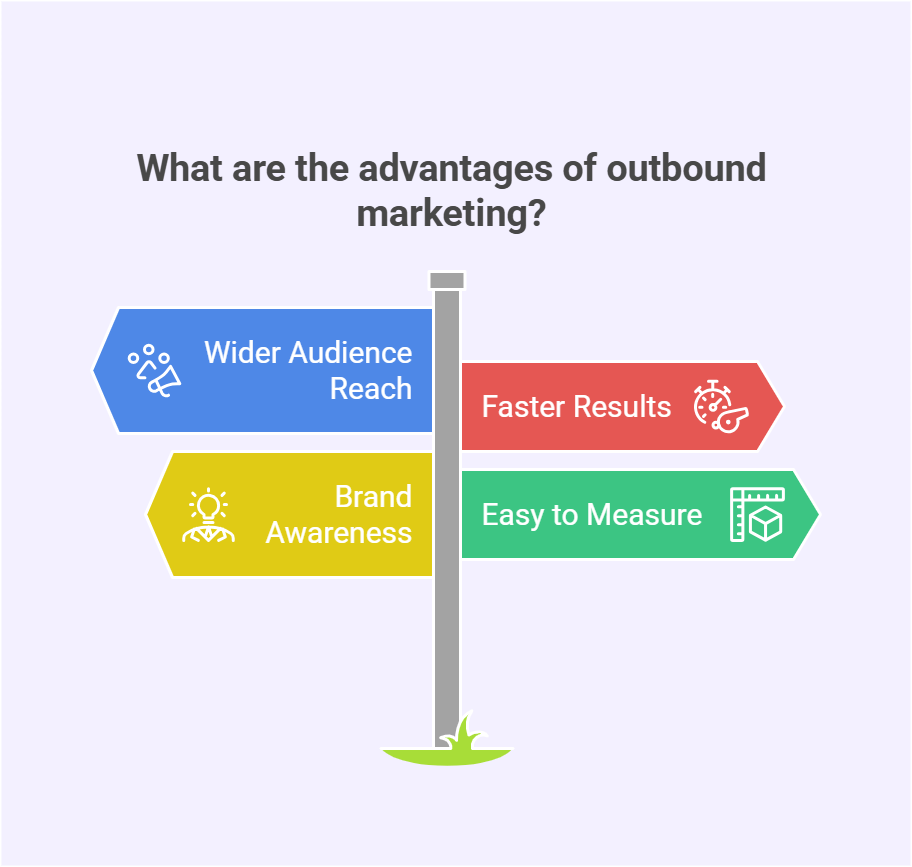
4. Challenges of Outbound Marketing
- High Costs: Traditional advertising and PPC campaigns require significant investment.
- Lower Engagement: Audiences may ignore or block ads, reducing effectiveness.
- Interruption Factor: Some consumers find outbound marketing intrusive, leading to negative perceptions.
- Declining Effectiveness: Modern consumers are more resistant to cold calls, emails, and ads due to oversaturation.
5. Outbound vs. Inbound Marketing: Key Differences
- Push vs. Pull Strategy: Outbound "pushes" messages, while inbound "pulls" in customers through valuable content.
- Paid vs. Organic: Outbound often requires financial investment, whereas inbound relies on organic engagement.
- Short-Term vs. Long-Term Benefits: Outbound yields faster results but requires ongoing investment, whereas inbound builds sustainable customer relationships.
6. Best Practices for Effective Outbound Marketing
- Targeted Campaigns: Use audience segmentation to improve ad relevance.
- Personalization: Customize messages for higher engagement and conversion.
- Omnichannel Approach: Combine multiple outbound strategies (PPC, cold outreach, events) for maximum impact.
- Follow-Up Strategies: Implement retargeting and nurture leads through email sequences and direct sales efforts.
Outbound marketing is effective for brand awareness and short-term sales targets, but it is generally more expensive and less engaging than inbound marketing strategies.
Key Differences: Inbound vs Outbound Marketing
| Feature | Inbound Marketing (BI) | Outbound Marketing (SI) |
|---|---|---|
| Approach | Attracts customers naturally | Pushes messages to customers |
| Targeting | Audience-driven (engages interested users) | Broad targeting (mass audience) |
| Communication | Two-way interaction | One-way messaging |
| Cost | Lower long-term cost (organic traffic) | Higher cost (paid advertising and sales efforts) |
| Effectiveness | Builds relationships and trust over time | Quick lead generation but lower trust |
| Return on Investment (ROI) | Higher over time | Can be lower if not targeted correctly |
Each strategy has its possess focal points and impediments, making the finest choice subordinate to your trade demonstration and targets.
Pros and Cons of Inbound and Outbound Marketing
1. Advantages of Inbound Marketing:
- Cost-effective in the long run, as organic traffic reduces paid advertising expenses.
- Builds trust and credibility by providing valuable and relevant content.
- Creates high-quality leads that are more likely to convert.
- Improves brand authority and positions businesses as industry leaders.
2. Challenges of Inbound Marketing:
- Requires time and effort to see significant results.
- Needs consistent content creation and SEO optimization.
- Can be highly competitive, especially in saturated industries.
3. Advantages of Outbound Marketing:
- Reaches more people quickly and ensures immediate brand visibility.
- Delivers instant results with targeted advertising campaigns.
- Effective for product launches, advertising campaigns, and short-term marketing goals.
- Enables direct sales and public relations to potential customers.
4. Challenges of Outbound Marketing:
- Can be expensive due to high advertising and outreach costs.
- Lower engagement and trust compared to inbound marketing.
- Risks being perceived as intrusive or irrelevant by the audience.
Risks are perceived as intrusive or irrelevant by the audience.
Which Strategy is Right for Your Business?
Selecting between inbound and outbound marketing depends on several factors:
1. Business Type and Industry:
- B2B companies prefer inbound marketing because it builds long-term relationships.
- B2C companies, including retail and eCommerce, employ outbound marketing for instant conversions.
2. Budget and Resources:
- Inbound marketing requires regular content production and patience but is more economical in the long term.
- Outbound marketing requires an initial investment but brings immediate benefits.
3. Target Audience Behavior:
- If your customers actively search for solutions, inbound marketing works better.
- If you must generate demand, outbound marketing helps find new leads.
How to Combine Inbound and Outbound Marketing for Maximum Impact?
Inbound marketing attracts customers, while outbound marketing reaches them directly. Instead of choosing one, businesses can integrate both for better reach, engagement, and conversions.
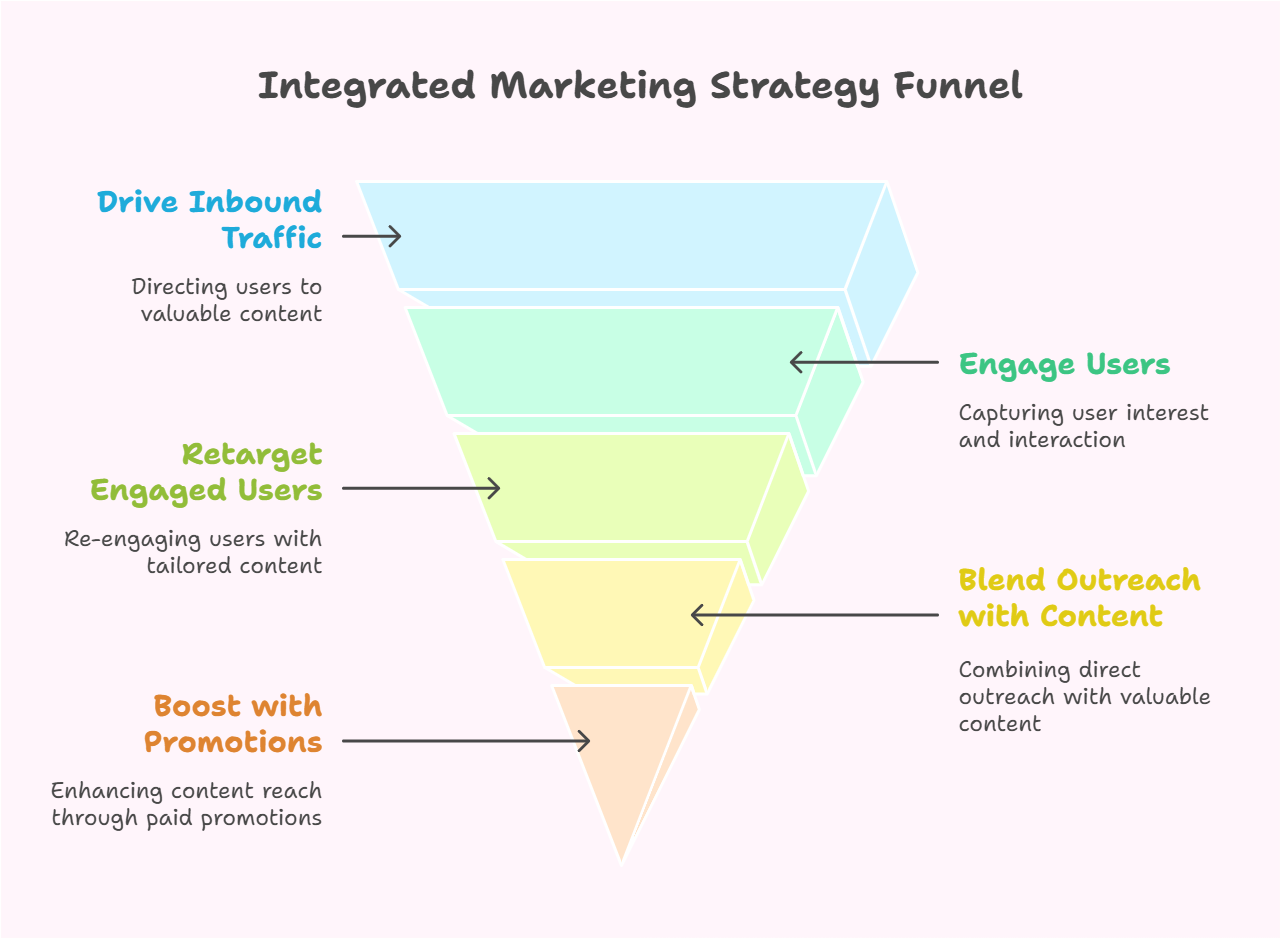
1. Use Outbound to Drive Inbound Traffic
Outbound tactics like paid ads and cold outreach can direct potential customers to valuable inbound content.
- Run Paid Ads: Use Google, Facebook, or LinkedIn Ads to drive traffic to blogs, ebooks, or webinars.
- Cold Outreach with Value: Share insights or case studies instead of a direct sales pitch.
- Direct Mail Campaigns: Include QR codes linking to useful content.
- Example: A SaaS company runs LinkedIn Ads to promote a free webinar, generating warm leads for the sales team.
2. Retarget Engaged Users
Retargeting ads help reconnect with users who engaged with your content but didn’t convert.
- Track Visitors: Use Facebook Pixel or Google Ads to retarget site visitors.
- Show Personalized Ads: Offer related content, discounts, or free trials.
- Follow Up with Emails: Nurture leads with additional resources.
- Example: A digital agency retargets users who read an SEO blog with ads offering a free SEO audit.
3. Blend Cold Outreach with Content
Instead of aggressive sales pitches, use valuable content in cold campaigns.
- Personalized Emails: Share insightful blogs, reports, or case studies.
- Cold Calls with Value: Mention a helpful article or webinar before pitching.
- Lead Nurturing: Send follow-up emails with additional resources.
- Example: A B2B software company shares an industry report in cold emails to warm up leads before pitching.
4. Boost Inbound Content with Paid Promotions
Social media is a powerful tool to expand your reach through both organic and paid methods.
- Boost High-Performing Content: Promote successful blogs or videos with paid ads.
- Leverage Influencers & Partners: Get your content shared by industry leaders.
- Engage in Industry Discussions: Build visibility through active participation.
- Example: A fitness brand runs Instagram ads to promote their best-performing workout guide.
The Role of Technology in Marketing Strategies
Technology has revolutionized marketing strategies, enabling businesses to reach their audience more effectively, automate processes, and measure performance in real-time. Digital tools like artificial intelligence (AI), big data analytics, and automation platforms have empowered marketers to optimize their campaigns for maximum impact.
AI-driven personalization has become a game-changer, allowing companies to tailor content and advertisements to individual user preferences. Machine learning algorithms analyze customer behavior to predict needs and suggest products, enhancing customer engagement. Additionally, marketing automation tools such as HubSpot and Marketo streamline email marketing, social media management, and lead nurturing, saving time and improving efficiency.
Another critical advancement is data analytics. With tools like Google Analytics and customer relationship management (CRM) software, businesses can gain deep insights into consumer behavior, track campaign performance, and refine strategies accordingly. This data-driven approach ensures that marketing efforts are targeted and cost-effective. Furthermore, emerging technologies like augmented reality (AR) and virtual reality (VR) are reshaping customer interactions. Brands use AR for virtual try-ons, immersive advertisements, and interactive product experiences, significantly enhancing customer engagement and purchase decisions.
Case Studies: Successful Inbound and Outbound Campaigns
1. Inbound Marketing: HubSpot’s Content-Driven Growth
HubSpot, a pioneer in inbound marketing, effectively leveraged content marketing, SEO, and automation to attract and retain customers. By providing high-quality blogs, free resources, and educational content, the company positioned itself as an industry leader. Their strategy involved offering free tools like website graders and templates, drawing in prospects who later converted into paying customers. HubSpot’s success demonstrates the power of providing value before making a sales pitch.
2. Outbound Marketing: Coca-Cola’s Personalization Campaign
Coca-Cola’s “Share a Coke” campaign is a classic example of successful outbound marketing. By personalizing bottle labels with popular names and running extensive TV, billboard, and social media ads, Coca-Cola created a sense of personal connection with customers. This strategy resulted in a significant increase in sales and brand engagement, proving that outbound marketing can be highly effective when executed creatively.
3. Hybrid Strategy: Nike’s Digital and Traditional Approach
Nike seamlessly integrates inbound and outbound marketing strategies. Their digital campaigns use compelling storytelling and influencer partnerships to attract organic traffic, while their high-budget TV and print ads ensure widespread brand awareness. By balancing inbound strategies like SEO-optimized content with outbound strategies like celebrity endorsements, Nike maintains a dominant presence in the market.
Generate More Leads with Smart Marketing!
Discover how to combine inbound and outbound strategies for better conversions.
Trends in Inbound and Outbound Marketing for 2025 and Beyond
As marketing evolves, several key trends are shaping the future of inbound and outbound strategies:
1. AI-Powered Personalization
Brands are increasingly using AI to create hyper-personalized experiences. AI-driven chatbots, predictive analytics, and recommendation engines help businesses deliver relevant content and product suggestions, enhancing customer satisfaction.
2. Voice Search and Conversational Marketing
With the rise of voice assistants like Alexa and Google Assistant, optimizing content for voice search is becoming crucial. Conversational marketing through AI-powered chatbots and messaging apps allows brands to engage with customers in real-time, improving customer service and conversions.
3. Interactive and Immersive Content
Augmented reality (AR), virtual reality (VR), and interactive videos are gaining traction. Brands that integrate immersive experiences into their marketing strategies will capture consumer attention and drive higher engagement rates.
4. Influencer and Community-Driven Marketing
Consumers are increasingly trusting recommendations from influencers and online communities over traditional advertisements. Brands collaborating with micro-influencers and leveraging community-driven marketing will see greater authenticity and customer loyalty.
5. Data Privacy and Ethical Marketing
As data regulations tighten, transparency and ethical marketing practices are more important than ever. Businesses that prioritize customer data protection and adopt privacy-first marketing strategies will gain consumer trust and long-term loyalty.
6. The Future of Outbound Marketing: Smarter, Not Louder
Outbound marketing is evolving with smarter targeting through programmatic advertising and AI-powered ad placement. Instead of bombarding audiences with generic ads, businesses will focus on precise targeting, ensuring that outbound efforts feel relevant rather than intrusive. By embracing these trends, businesses can stay ahead of the competition and craft marketing strategies that resonate with their audience in 2025 and beyond.
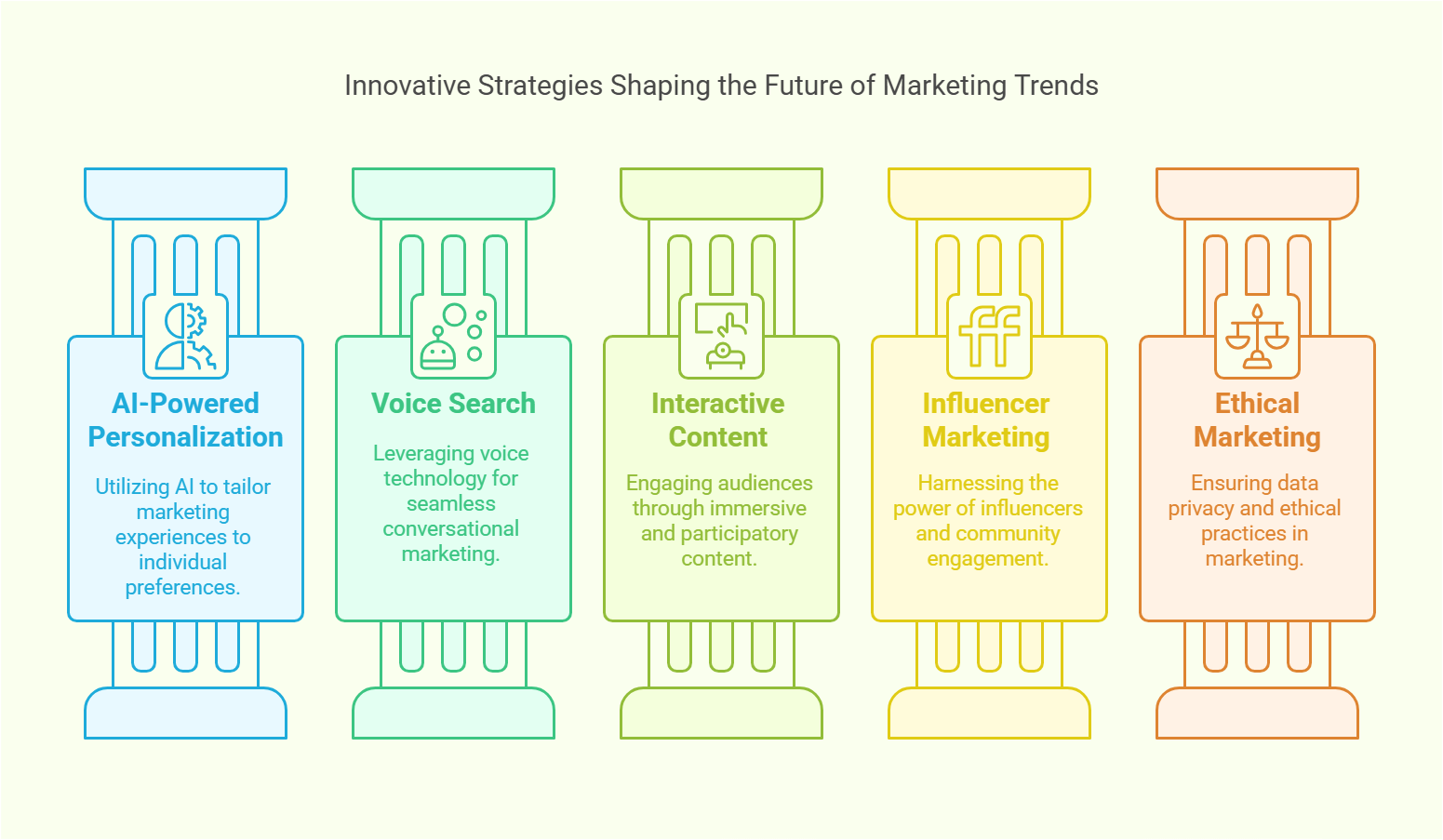
Conclusion
Domestic and outward marketing is playing an essential role in business growth. Entering marketing focuses on creating long -term relationships thanks to valuable content, while marketing goes to stimulate the results immediately through direct promotions.
A hybrid approach takes advantage of two strategies to help companies optimize their marketing efforts effectively. At PrimeRole, we understand the importance of balancing inbound and outbound tactics to achieve sustained growth and success. The evaluation of your commercial, budget and public models will determine the best combination of marketing tactics and your success.
Frequently Ask questions(FAQs) on Inbound vs Outbound Marketing
Is inbound marketing better than outbound marketing?
Not necessarily! Inbound marketing is cost-effective and builds trust, while outbound marketing provides faster results. The best choice depends on your business needs.
How long does inbound marketing take to show results?
Inbound marketing can take 3-6 months to generate steady traffic and leads, but the results are long-lasting.
Can small businesses afford inbound marketing?
Absolutely! Inbound marketing is budget-friendly and can be scaled with content creation, SEO, and organic social media marketing.
